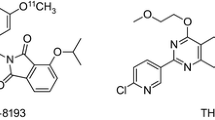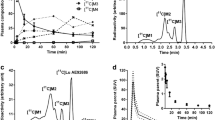Abstract
Purpose
(R)-[11C]rolipram and (S)-[11C]rolipram have been proposed to investigate phosphodiesterase-4 and, indirectly, cAMP-mediated signaling with PET. This study assessed binding of these tracers to phosphodiesterase-4 in canine myocardium.
Procedures
Seven dogs underwent (R)-[11C]rolipram and (S)-[11C]rolipram dynamic PET imaging at baseline and with co-injection of saturating doses of (R)-rolipram. Dual-input compartment models were applied to estimate the volumes of distribution (V T).
Results
The model comprising one compartment for unmetabolized tracer and one compartment for labeled metabolites provided excellent fits to data acquired with (S)-[11C]rolipram at baseline and with both enantiomers during co-injection scans. Use of two compartments for unmetabolized (R)-[11C]rolipram at baseline was warranted according to Akaike and Schwarz criteria. V T estimates obtained with these models were robust (CV ≤ 8.2%) and reproducible (CV ≤ 15%).
Conclusion
An important fraction (~65%) of the V T of (R)-[11C]rolipram at baseline reflects specific binding. Thus, the latter may be a useful index of phosphodiesterase-4 levels in canine myocardium.






Similar content being viewed by others
References
Houslay MD (2001) PDE4 cAMP-specific phosphodiesterases. Prog Nucleic Acid Res Mol Biol 69:249–315
Laliberte F, Liu S, Gorseth E et al (2002) In vitro PKA phosphorylation-mediated human PDE4A4 activation. FEBS Lett 512:205–208
Movsesian MA (1998) cAMP-mediated signal transduction and sarcoplasmic reticulum function in heart failure. Ann NY Acad Sci 853:231–239
Takahashi K, Osanai T, Nakano T, Wakui M, Okumura K (2002) Enhanced activities and gene expression of phosphodiesterase types 3 and 4 in pressure-induced congestive heart failure. Heart Vessels 16:249–256
Torphy TJ (1998) Phosphodiesterase isozymes: molecular targets for novel antiasthma agents. Am J Respir Crit Care Med 157:351–370
Wachtel H (1990) The second-messenger dysbalance hypothesis of affective disorders. Pharmacopsychiatry 23:27–32
DaSilva JN, Lourenco CM, Wilson AA, Houle S (2001) Syntheses of the phosphodiesterase-4 inhibitors [11C]Ro 20-1724, R-, R/S- and S-[11C]rolipram. J Label Compd Radiopharm 44:373–384
DaSilva JN, Lourenco CM, Meyer JH, Hussey D, Potter WZ, Houle S (2002) Imaging cAMP-specific phosphodiesterase-4 in human brain with R-[11C]rolipram and positron emission tomography. Eur J Nucl Med 29:1680–1683
Fujita M, Zoghbi SS, Crescenzo MS et al (2005) Quantification of brain phosphodiesterase 4 in rat with (R)-[11C]rolipram-PET. Neuroimage 26:1201–1210
Harada N, Hishiyama S, Ohba H, Sato K, Kakiuchi T, Tsukada H (2002) Age differences in phosphodiesterase type-IV and its functional response to dopamine D1 receptor modulation in the living brain: a PET study in conscious monkeys. Synapse 44:139–145
Parker CA, Matthews JC, Gunn RN et al (2005) Behaviour of [11C]R(−)-and [11C]S(+)-rolipram in vitro and in vivo, and their use as PET radiotracers for the quantificative assay of PDE4. Synapse 55:270–279
Tsukada H, Fukumoto D, Nishiyama S, Sato K, Kakiuchi T (2004) Transient focal ischemia affects the cAMP second messenger system and coupled dopamine D1 and 5-HT1A receptors in the living monkey brain: a positron emission tomography study using microdialysis. J Cereb Blood Flow Metab 24:898–906
Tsukada H, Harada N, Ohba H, Nishiyama S, Kakiuchi T (2001) Facilitation of dopaminergic neural transmission does not affect [11C]SCH23390 binding to the striatal D1 dopamine receptors, but the facilitation enhances phosphodiesterase type-IV activity through D1 receptors: PET studies in the conscious monkey brain. Synapse 42:258–265
Itoh T, Abe K, Zoghbi SS et al (2009) PET measurement of the in vivo affinity of 11C-(R)-Rolipram and the density of its target, phosphodiesterase-4, in the brains of conscious and anesthetized rats. J Nucl Med 50:749–756
Kenk M, Greene M, Thackeray J et al (2007) In vivo selective binding of (R)-[11C]rolipram to phosphodiesterase-4 provides the basis for studying intracellular cAMP signaling in the myocardium and other peripheral tissues. Nucl Med Biol 34:71–77
Lourenco CM, Houle S, Wilson AA, DaSilva JN (2001) Characterization of R-[11C]rolipram for PET imaging of phosphodiesterase-4: in vivo binding, metabolism, and dosimetry studies in rats. Nucl Med Biol 28:347–358
Lourenco CM, Kenk M, Beanlands RS, DaSilva JN (2006) Increasing synaptic noradrenaline, serotonin and histamine enhances in vivo binding of phosphodiesterase-4 inhibitor (R)-[11C]rolipram in rat brain, lung and heart. Life Sci 79:356–364
Thomas AJ, DaSilva JN, Lortie M et al (2011) PET of (R)-11C-rolipram binding to phosphodiesterase-4 is reproducible and sensitive to increased norepinephrine in the rat heart. J Nucl Med 52:263–269
Krause W, Kühne G (1988) Pharmacokinetics of rolipram in the rhesus and cynomolgus monkeys, the rat and the rabbit. Studies on species differences. Xenobiotica 18:561–761
Krause W, Kühne G (1992) High-performance liquid chromatographic procedure for specificity testing of radioimmunoassays: rolipram. J Chromatogr 573:303–308
Kenk M, Green M, Lortie M, deKemp RA, Beanlands RS, DaSilva JN (2008) Use of a column-switching high-performance liquid chromatography method to assess the presence of specific binding of (R)-and (S)-[11C]rolipram and their labeled metabolites to the phosphodiesterase-4 enzyme in rat plasma and tissues. Nucl Med Biol 35:515–521
Townsend DW, Beyer T, Jerin J, Watson CC, Young J, Nutt R (1999) The ECAT ART scanner for positron emission tomography. 1. Improvements in performance characteristics. Clin Positron Imaging 2:5–15
Schäfers KP, Spinks TJ, Camici PG et al (2002) Absolute quantification of myocardial blood flow with H 152 O and 3-dimensional PET: an experimenal validation. J Nucl Med 43:1031–1040
Watson CC, Newport D, Casey ME, deKemp RA, Beanlands RS (1997) Evaluation of simulation-based scatter correction for 3-D PET cardiac imaging. IEEE Trans Nucl Sci 44:90–97
deKemp RA, Nahmias C (1996) Automated determination of the left ventricular long axis in cardiac positron tomography. Physiol Meas 17:95–108
Laubenbacher C, Rothley J, Sitomer J et al (1993) An automated analysis program for the evaluation of cardiac PET studies: initial results in the detection and localization of coronary artery disease using nitrogen-13-ammonia. J Nucl Med 34:968–978
Klein R, Renaud JM, Ziadi MC et al (2010) Intra- and inter-operator repeatability of myocardial blood flow and myocardial flow reserve measurements using rubidium-82 pet and a highly automated analysis program. J Nucl Cardiol 17:600–616
Hutchins GD, Schwaiger M, Rosenspire KC, Krivokapich J, Schelbert H, Kuhl DE (1990) Noninvasive quantification of regional blood flow in the human heart using N-13 ammonia and dynamic positron emission tomographic imaging. J Am Coll Cardiol 15:1032–1042
Innis RB, Cunningham VJ, Delforge J et al (2007) Consensus nomenclature for in vivo imaging of reversibly binding radioligands. J Cereb Blood Flow Metab 27:1533–1539
Trust region methods for nonlinear minimization. Optimization toolbox user’s guide. The Mathworks; 2000: 3.3–3.5
Landaw EM, DiStefano JJ (1984) Multiexponential, multicompartmental, and noncompartmental modeling. II. Data analysis and statistical considerations. Am J Physiol 246:R665–R677
Akaike H (1974) A new look at the statistical model identification. IEEE Trans Autom Control 19:716–723
Schwarz G (1978) Estimating the dimension of a model. Ann Stat 6:461–464
Logan J, Fowler JS, Volkow ND et al (1990) Graphical analysis of reversible radioligand binding from time-activity measurements applied to [N-11C-methyl]-(−)-cocaine PET studies in human subjects. J Cereb Blood Flow Metab 10:740–747
Kanji GK (1993) 100 statistical tests. Sage, Newbury Park
Hume SP, Gunn RN, Jones T (1998) Pharmacological constraints associated with positron emission tomographic scanning of small laboratory animals. Eur J Nucl Med 25:173–176
Price JC, Lopresti BJ, Meltzer CC et al (2001) Analyses of [18F]altanserin bolus injection PET data. II: Consideration of radiolabeled metabolites in humans. Synapse 41:11–21
Osadchii OE (2007) Myocardial phosphodiesterases and regulation of cardiac contractility in health and cardiac disease. Cardiovasc Drugs Ther 21:171–194
Singal PK, Deally CMR, Weinberg LE (1987) Subcellular effects of adriamycin in the heart: a concise review. J Mol Cell Cardiol 19:817–828
Movsesian MA (2000) Therapeutic potential of cyclic nucleotide phosphodiesterase inhibitors in heart failure. Exp Opin Invest Drugs 9:963–973
Acknowledgments
The authors thank Dr. Roger Gunn for helpful discussions. The authors also thank the University of Ottawa Heart Institute Animal Care Veterinary Service for assistance with experimental animals, the University of Ottawa Heart Institute Cardiac PET radiochemistry staff for the synthesis of (R)-[11C]rolipram and (S)-[11C]rolipram, as well as James Thackeray, Michael Greene, and Maryam Parsanejad for their assistance during imaging sessions. This work was supported in part by a grant from the Canadian Institutes of Health Research (MOP 62765) and in part by the Heart and Stroke Foundation of Ontario (HSFO) Program Grant on Molecular Function and Imaging (PRG6242). R. S. Beanlands is a Career Investigator supported by the Heart and Stroke Foundation of Ontario.
Conflict of Interest
The authors declare that they have no conflict of interest.
Author information
Authors and Affiliations
Corresponding author
Rights and permissions
About this article
Cite this article
Lortie, M., DaSilva, J.N., Kenk, M. et al. Analysis of (R)- and (S)-[11C]rolipram Kinetics in Canine Myocardium for the Evaluation of Phosphodiesterase-4 with PET. Mol Imaging Biol 14, 225–236 (2012). https://doi.org/10.1007/s11307-011-0482-6
Published:
Issue Date:
DOI: https://doi.org/10.1007/s11307-011-0482-6




